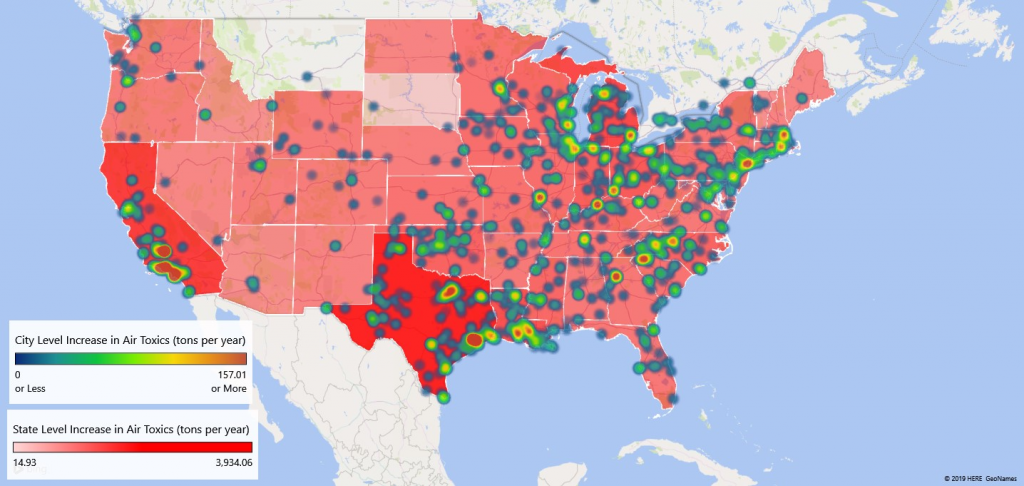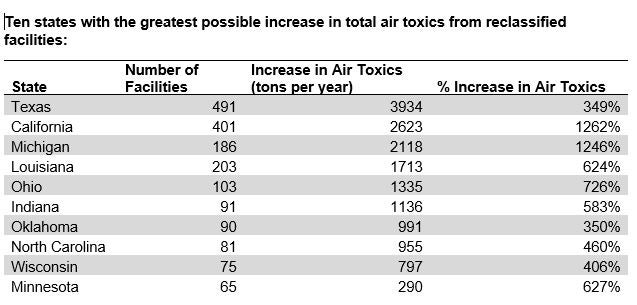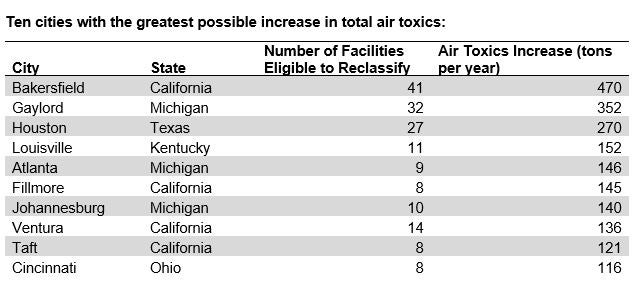Over the last few decades, EPA has issued numerous Clean Air Act protections to curb dangerous air pollution from large industrial sources. Now, however, a proposed Trump Administration loophole threatens to undermine that effort – and data released by EPA itself shows how this loophole might expose millions of Americans to a huge increase in toxic air pollution.

Possible increase in total air toxic emissions from a subset of facilities eligible to reclassify under the air toxics loophole, aggregated at state and city level. In many areas, this loophole could lead to a quadrupling of air toxics from these facilities. Graphic by EDF.
Last July, EPA Administrator Andrew Wheeler proposed to create an air toxics loophole allowing large industrial facilities to increase their emissions of dangerous pollutants. When this proposed rule first emerged, EDF pointed out that EPA’s own data shows more than 3,900 large industrial facilities across the country are potentially eligible to take advantage of this loophole.
But additional data on just a subset of these facilities, released by EPA after the proposal came out, indicates that the proposal could lead to millions of pounds of additional toxic air pollution across 48 states – with many of these facilities located in areas where millions of Americans live and work.
The proposed air toxics loophole would undermine clean air safeguards for large industrial facilities across the country that are currently subject to stringent standards for the emission of mercury, benzene, and other hazardous air pollutants that may cause cancer and have other harmful health impacts. Under the proposal, many of these facilities would be eligible to “reclassify” themselves as smaller sources subject to weaker standards or no standards at all – and therefore could operate with weaker, or no, air pollution controls.
(The proposal would codify a four-page memo that Trump’s EPA issued in January 2018 – with no analysis of air pollution or health impacts. EDF, a coalition of environmental groups, and the State of California challenged that memo in court. Although the D.C. Circuit rejected these challenges on procedural grounds, the court also found that the memo has no legal force or effect and cannot be relied upon by state permitting authorities or sources.)
In September, EDF and 34 public health, environmental justice, labor and environmental organizations submitted comments strongly opposing the proposed rule. EDF and four other environmental organizations also submitted detailed technical and legal comments emphasizing the danger the rule poses to public health.
Near the close of the comment period, EPA released additional data, including identifying information for specific facilities that could be eligible to reclassify under the proposed rule. EDF analyzed this additional data for clues about the devastating health and environmental impacts the air toxics loophole could have. In response to this additional data, EDF submitted supplemental comments to EPA.
Among other things, our analysis found:
- EPA’s data covers more than 2,500 facilities that would be eligible to reclassify and increase their emission of dangerous pollutants. EPA identified more than 2,500 facilities that are currently subject to stringent Maximum Achievable Control Technology standards but under the loophole could avoid complying with those standards. This large number of facilities still represents only a subset of the nearly 4,000 facilities nationwide that EPA estimated would be potentially eligible to reclassify under the proposal.
- A potential 480% increase in nationwide emissions of air toxics from these facilities. While it’s difficult to know if and by how much facilities would increase emissions if they were to take advantage of the proposed loophole, EDF estimates that total air toxics emissions could increase by about 49.2 million pounds per year if all the eligible facilities were to increase their emissions to the maximum extent permitted under the loophole. (The value was estimated by looking at the difference between current total air toxics emissions at these facilities and emissions if facilities increased total air toxics emissions to 75% of 25 tons per year – the threshold that would make these facilities major again – consistent with EPA’s approach.) Due to missing data for some of the facilities on the EPA list, however, this estimate is based on only 60% of the 2,500 facilities identified by EPA – so it could well underestimate the potential increase in emissions that would result from this proposal.

- The proposed rule could expose millions of Americans in communities across the country to increases in toxic air pollution. Our analysis found facilities potentially eligible to use the loophole to increase their emissions of dangerous pollutants in 48 states. The greatest increases are concentrated in Texas, California, Michigan, and Louisiana. More than 3.7 million people live in the ten cities with the greatest possible increase in air toxics from this loophole.

After EPA issued the January 2018 memo that first opened the air toxics loophole, EDF issued a white paper finding that it could affect as many as 26 facilities in the Houston-Galveston region alone – and lead to hundreds of thousands of pounds of additional toxic pollution. Now, EPA’s own data reinforces the devastating impact of this loophole, from California to Michigan. EDF will continue to oppose this dangerous failure of EPA to uphold its responsibility to safeguard human health and the environment.
By Taylor Bacon
Enviroshop is maintained by dedicated NetSys Interactive Inc. owners & employees who generously contribute their time to maintenance & editing, web design, custom programming, & website hosting for Enviroshop.
